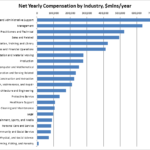My First Webcomic. #FridayDelirium #TerriblePuns
Galleries
It’s 2012. Is this really still the most profitable kind of online advertising?
Chart of the day: approximate value add by occupation!
I was wondering today what percentage of American’s time is spend doing different types of work. A quick Google search failed miserably, so I decided to just answer the question myself, with help from our old friend the Bureau of Labor Statistics!
The BLS publishes data showing how many people are employed in each industry, and how much those people earn on average per year. That’s enough to give us approximately what we want.
If we know how many people are employed in each job, and we assume that people in different jobs work approximately the same number of hours per week (which is obviously not true since an investment banker might regularly work 3x as many hours as a postman), then we could just divide employment in each respective industry by total employment to get % of work time spent in each occupation.
But that’s not quite satisfying, because it doesn’t deal with the fact that, in terms of economic value added, one worker’s time is not the same as another. In other words, if a teenager who spends an hour working at the GAP may be very diligent and hardworking, but he’s just not adding as much value as a surgeon who spends an hour removing a brain tumor.
One rough measure of how much value different occupations add per hour is relative wages. There are obviously huge distortions and inefficiencies in how much different workers get paid, but it is approximately true to say that “if Susie the Doctor earns 4x as much per hour as Johnnie the retail clerk, then Susie’s time is 4x as valuable to the economy”.
Now luckily for us, the BLS also reports average annual compensation by occupation.
So if we just multiply total employment by occupation by annual compensation by occupation, we end up with total yearly compensation by industry, which is a pretty good rough measure of how scarce time is allocated in the American economy.
I was actually a bit surprised by the result, though it makes sense when I look at it. There are an awful lot of people providing office support. And there are surprisingly few farmers given how much attention farming gets in the national discourse.
Small cat, big hallway.
The perils of your roommate having a dog.
The rain in New York falls mainly…everywhere, all the time.
Except right now I guess.
I’m losing a lot of respect for meteorologists right now.





